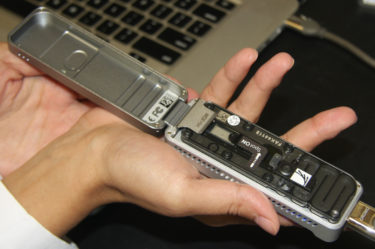Graduate Student Explores Potential of Handheld DNA/RNA Sequencers in Outbreaks
| Imagine there’s an outbreak of an infectious disease. Could health officials on the ground harness the power of new handheld DNA and RNA sequencers to monitor outbreaks in real-time and quickly contain them?
This question lies at the heart of research published in the journal Infection, Genetics and Evolution by UAMS graduate student Duah Alkam. She and her advisers from the College of Medicine Department of Biomedical Informatics and the Department of Microbiology and Immunology collaborated with the Arkansas Department of Health to look at specimens collected during a 2016 mumps outbreak in Northwest Arkansas.
It took the Human Genome Project 13 years to complete the first sequence of a human genome in 2003. As sequencers became available for purchase, they were large, expensive and slow.

Alkam used the the Oxford Nanopore Technologies MinION to sequence the samples in her study.Amy Widner
That has changed. Alkam used a device called the Oxford Nanopore Technologies MinION to sequence each sample in a matter of hours. To offload the data, she simply connected the MinION through a USB port to a laptop.
“You see results on your computer in real time,” Alkam said. “It’s fast, affordable and simple. The idea is that something like this might be useful during an outbreak, especially in a rural setting. If you can quickly identify a strain, you’re that much closer to understanding the origin of the outbreak, which may help contain it and protect the at-risk population.”
The new challenge for scientists is how to interpret the massive amount of data produced by these powerful sequencers. That is where the relatively new field of biomedical informatics comes in.
“Biomedical informatics allows us to look at genomes within a matter of hours and compare them, pinpointing connections and what might be important about these datasets,” Alkam said. “In this way, biomedical informatics is sort of the bridge between raw data and relevant information.”
In this case, Alkam was able to determine the unique characteristics of the specific variation of the mumps virus that was behind the 2016 outbreak. They used a computational technique called immunoinformatics to plot a “family tree” of sorts for the virus.
“We found that it was very similar to a strain that started an outbreak in Massachusetts around the same time in 2016, and it was also related to another strain that spread in Washington state, which may suggest that all three outbreaks originated from the same strain.”
While Alkam’s experiment was not conducted during an active outbreak, she and her advisers believe the results demonstrate great promise for the technique to be applied in the real world. Earlier in 2019, other scientists in the Department of Bioinformatics collaborated with researchers around the world for the first demonstration that the MinION could be used for the rapid genetic sequencing of multiple human viruses.
“The possibility of infectious disease outbreaks in health care settings and communities is something that unites us across the globe. We’re all vulnerable,” said Se-Ran Jun, Ph.D., Alkam’s adviser for the project and an assistant professor in biomedical informatics. “So at UAMS, it’s exciting each time we demonstrate how we can harness the power of new sequencing technology, big data science and analytics, and high performance computing in biomedical informatics to offer solutions.”
The project was funded with a grant to Jun from the UAMS for Translational Research Institute.
Alkam is a student in the UAMS Graduate School’s Graduate Program in Interdisciplinary Biomedical Sciences (GPIBS). Her other advisers are David Ussery, Ph.D., a professor in the Department of Biomedical Informatics; and Mark Smeltzer, Ph.D., a professor in the Department of Microbiology and Immunology.
